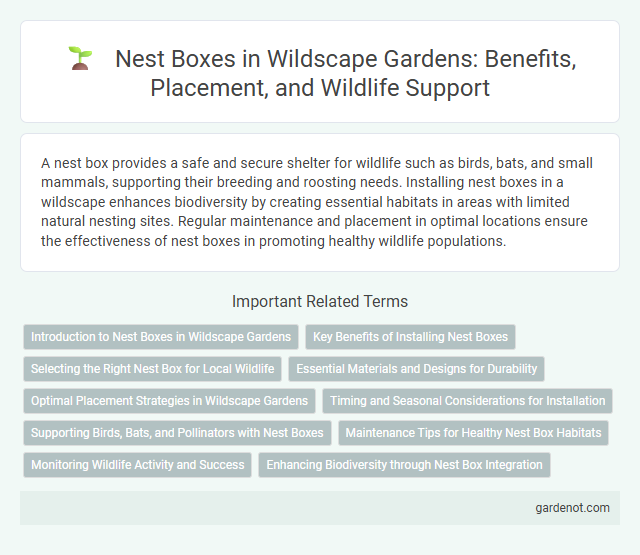A nest box provides a safe and secure shelter for wildlife such as birds, bats, and small mammals, supporting their breeding and roosting needs. Installing nest boxes in a wildscape enhances biodiversity by creating essential habitats in areas with limited natural nesting sites. Regular maintenance and placement in optimal locations ensure the effectiveness of nest boxes in promoting healthy wildlife populations.
Introduction to Nest Boxes in Wildscape Gardens
Nest boxes in Wildscape Gardens provide essential shelter and breeding sites for local wildlife, boosting biodiversity and supporting ecosystem health. These expertly designed structures cater to various species, including birds, bats, and small mammals, encouraging natural behaviors and enhancing habitat complexity. Strategic placement of nest boxes in gardens improves species survival rates and fosters a thriving, balanced environment.
Key Benefits of Installing Nest Boxes
Installing nest boxes significantly boosts local biodiversity by providing essential safe breeding habitats for birds, bats, and small mammals. These artificial shelters help increase species populations, especially in urban or deforested areas where natural nesting sites are scarce. Nest boxes also support ecological balance by encouraging the presence of predators that regulate pests, enhancing the overall health of the ecosystem.
Selecting the Right Nest Box for Local Wildlife
Selecting the right nest box for local wildlife requires understanding species-specific habitat preferences and nesting behaviors to enhance breeding success. Materials such as untreated wood and appropriate dimensions tailored to target species like bluebirds, owls, or bats contribute to durability and safety. Proper placement at suitable heights and orientations within the wildscape supports natural instincts and protects inhabitants from predators and harsh weather.
Essential Materials and Designs for Durability
Nest boxes constructed from high-quality cedar wood ensure longevity and natural insulation, resisting decay and weather damage. Designs featuring sloped roofs, drainage holes, and ventilation slots enhance durability by preventing water accumulation and promoting airflow. Using stainless steel screws and non-toxic, weatherproof paint further protects the structure against harsh outdoor conditions.
Optimal Placement Strategies in Wildscape Gardens
Optimal placement of nest boxes in wildscape gardens enhances biodiversity by providing safe breeding habitats for native bird species. Position nest boxes at least 3 to 5 meters above ground level, facing away from prevailing winds and direct sunlight to ensure protection from predators and weather conditions. Positioning boxes near natural vegetation and water sources increases occupancy rates by mimicking birds' preferred nesting environments.
Timing and Seasonal Considerations for Installation
Nest box installation in wildscapes should be timed to align with the breeding season of target bird species, typically early spring before egg-laying begins. Installing boxes in late winter ensures birds have adequate time to explore and select suitable nesting sites, enhancing occupancy rates. Seasonal considerations also involve avoiding periods of extreme weather or heavy foliage growth to maintain accessibility and visibility for prospective nesters.
Supporting Birds, Bats, and Pollinators with Nest Boxes
Nest boxes designed for Wildscape habitats provide essential shelter and breeding sites for birds, bats, and pollinators, enhancing local biodiversity. Installing species-specific nest boxes supports populations of cavity-nesting birds like blue tits, nocturnal bats such as pipistrelles, and solitary bees crucial for pollination. These structures contribute to ecosystem health by promoting natural pest control and improving plant reproduction through increased pollinator activity.
Maintenance Tips for Healthy Nest Box Habitats
Regularly cleaning nest boxes by removing old nesting materials prevents parasite buildup and promotes healthy bird populations. Inspecting for damage, such as cracks or loose fittings, ensures the structure remains safe and secure for nesting wildlife. Positioning nest boxes away from direct sunlight and predators enhances habitat quality and increases the chances of successful breeding.
Monitoring Wildlife Activity and Success
Nest boxes provide critical shelters that support breeding success and increase population stability for various bird and mammal species. Regular monitoring through remote cameras and periodic inspections captures valuable data on occupancy rates, species diversity, and reproductive outcomes. This information guides adaptive management strategies to optimize habitat conditions and enhance overall wildlife conservation efforts within wildscape environments.
Enhancing Biodiversity through Nest Box Integration
Nest box integration significantly boosts local biodiversity by providing essential shelter for various bird species, bats, and small mammals, fostering healthier ecosystems. These artificial habitats compensate for the loss of natural nesting sites caused by urbanization and deforestation, supporting species population stability and growth. Incorporating nest boxes into wildscape planning promotes species diversity and aids conservation efforts by creating safe breeding environments.
Nest box Infographic

 gardenot.com
gardenot.com